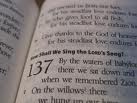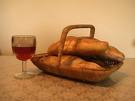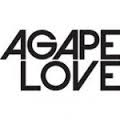| Next | Previous | Index | Tellout Home |
12. Agape Worship Meal
A Love Feast
 An "Agape Worship Meal," otherwise called a "Love Feast," is described as a religious meal held initially by early Christians, which eventually developed into the service of Holy Communion. "Agape" is the New Testament Greek word for "self-giving love." Christians sometimes hold an Agape worship meal on Maundy Thursday before Good Friday and Easter Sunday. Saint Paul hints at a dinner in Early Church development before the communion in 1 Corinthians 11.20-22. "When you meet together, you are not interested in the Lord's Supper. For some of you, hurry to eat your meal without sharing it with others. As a result, some go hungry while others get drunk. What? Don't you have your own homes for eating and drinking?" It is evident from Saint Paul's letter that there are abuses present when some eat heartily and others go hungry. The Early Church's answer to this problem was to separate off the Agape worship meal from the worship time. Today, a conference may use a modern Agape in a conference center or a church hall. The room should be comfortable and maybe lit with candles for ambiance. Arrange the tables and chairs in a "U" "horseshoe" shape with people facing each other.✞
An "Agape Worship Meal," otherwise called a "Love Feast," is described as a religious meal held initially by early Christians, which eventually developed into the service of Holy Communion. "Agape" is the New Testament Greek word for "self-giving love." Christians sometimes hold an Agape worship meal on Maundy Thursday before Good Friday and Easter Sunday. Saint Paul hints at a dinner in Early Church development before the communion in 1 Corinthians 11.20-22. "When you meet together, you are not interested in the Lord's Supper. For some of you, hurry to eat your meal without sharing it with others. As a result, some go hungry while others get drunk. What? Don't you have your own homes for eating and drinking?" It is evident from Saint Paul's letter that there are abuses present when some eat heartily and others go hungry. The Early Church's answer to this problem was to separate off the Agape worship meal from the worship time. Today, a conference may use a modern Agape in a conference center or a church hall. The room should be comfortable and maybe lit with candles for ambiance. Arrange the tables and chairs in a "U" "horseshoe" shape with people facing each other.✞
Call to Worship
 The leader should distribute the Gospel and Epistle readings in written form for everybody in advance. The service begins with a worship call, such as "The Lord be with you," assuming people have arrived and are engaged in casual conversation.✞
The leader should distribute the Gospel and Epistle readings in written form for everybody in advance. The service begins with a worship call, such as "The Lord be with you," assuming people have arrived and are engaged in casual conversation.✞
Hand Washing
 One person with a jug of warm water and bowl, another with a towel pass around the group and pour water over each person's hands. They say, "This is a reminder of Jesus' love and servanthood." Then, "In Jesus' name, we welcome you to this Agape Meal." The persons with the jug and the towel have their hands washed last of all.✞
One person with a jug of warm water and bowl, another with a towel pass around the group and pour water over each person's hands. They say, "This is a reminder of Jesus' love and servanthood." Then, "In Jesus' name, we welcome you to this Agape Meal." The persons with the jug and the towel have their hands washed last of all.✞
- Opening prayer.
- Epistle Reading.
- First Course in the meal.
Wine Bread Water
 A household of faith group may share the wine and bread after a Gospel reading and some general prayers. A public conversation then may take place over the Agape wine and food sharing. A volunteer may read a poem or give a testimony. After the first course of the dinner, all stand for the Gospel. A 3-5 minute interactive moment follows after the Gospel. What do people think of this or that? After the general conversation, the main course begins with testimonies or poems.✞
A household of faith group may share the wine and bread after a Gospel reading and some general prayers. A public conversation then may take place over the Agape wine and food sharing. A volunteer may read a poem or give a testimony. After the first course of the dinner, all stand for the Gospel. A 3-5 minute interactive moment follows after the Gospel. What do people think of this or that? After the general conversation, the main course begins with testimonies or poems.✞
Separate Little Communion Cups
A Scripture reading is shared instead of the formal Prayer of Consecration used by many churches. Two people then administer the bread and wine with the words "Christ's body" and "Christ's blood." The wine should be in separate little cups rather than a communal container or vessel. Archbishop Finlay of the Anglican Diocese of Toronto insisted on individual cups when he approved this format. The congregation can consume the bread and wine immediately or together at the end. Open prayer, the laying on of hands, and anointing with oil are appropriate. Someone should pray for the church, the world, the sick's needs, the dying, civic leaders, and general personal prayers. All may say together at the end, "Glory to God from generation to generation..." Blow out the candles to signal the end of the Agape Love Meal.✞
The Lord's Teaching
 Say a Collect or prayer for the day, then a passage of scripture appropriate to the occasion, or one of the following selections. "God so loved the world that he gave his only Son, that whoever believes in him should not perish, but have eternal life." John 6.35 Jesus said, "I am the bread of life; whoever comes to me shall not hunger, and whoever believes in me shall never thirst." The teaching should be on the Gospel, Epistle, or other set Bible passages. A confession of sin may follow. Use the following form.
Say a Collect or prayer for the day, then a passage of scripture appropriate to the occasion, or one of the following selections. "God so loved the world that he gave his only Son, that whoever believes in him should not perish, but have eternal life." John 6.35 Jesus said, "I am the bread of life; whoever comes to me shall not hunger, and whoever believes in me shall never thirst." The teaching should be on the Gospel, Epistle, or other set Bible passages. A confession of sin may follow. Use the following form.
Leader "Most merciful God, we confess that we have sinned against you in thought, word, and deed, by what we have done and by what we have left undone. We have not loved you with our whole heart; we have not loved our neighbors as ourselves. We are truly sorry, and we humbly repent. For the sake of your Son Jesus Christ, have mercy on us and forgive us, that we may delight in your will, and walk-in your ways, to the glory of your name. Amen"✞
Communion Services
 According to Jesus' teaching, the Communion service, the Mass or The Lord's Supper, was instituted in the Upper Room. When a clergy person or the bishop is present, a home may hold a Eucharist or Holy Communion service but not more than one week in four. The Communion service may be alternately called the Lord's Supper (in many Protestant Churches), the Mass (in the Roman Catholic Church), or the Eucharist (in many Anglican Churches.) Celebrate it from an approved service like that of the Anglican B.A.S. or other recommended texts for worship services or commonly used format as in the Baptist Church.✞
According to Jesus' teaching, the Communion service, the Mass or The Lord's Supper, was instituted in the Upper Room. When a clergy person or the bishop is present, a home may hold a Eucharist or Holy Communion service but not more than one week in four. The Communion service may be alternately called the Lord's Supper (in many Protestant Churches), the Mass (in the Roman Catholic Church), or the Eucharist (in many Anglican Churches.) Celebrate it from an approved service like that of the Anglican B.A.S. or other recommended texts for worship services or commonly used format as in the Baptist Church.✞
The Lord's Supper
 The Gospel or Epistle set Lectionary readings may determine the teaching for the day. Sometimes an Old Testament reading also may be used. A sharing time when individuals can share their views and questions can occur after the teaching to discuss any matters arising from the text and its relevance today. The following is a short form of service suitable for a Household of Faith home communion service.✞
The Gospel or Epistle set Lectionary readings may determine the teaching for the day. Sometimes an Old Testament reading also may be used. A sharing time when individuals can share their views and questions can occur after the teaching to discuss any matters arising from the text and its relevance today. The following is a short form of service suitable for a Household of Faith home communion service.✞
Household of Faith
 Leader. "Let us pray."
Leader. "Let us pray."
"Brothers and sisters in Christ, God calls us to faithful service by the proclamation of the word and sustains us with the sacrament of Christ's body and blood. Hear now God's word, and receive this holy food from the Lord's table."✞
Deliver Us From Evil
 We pray that the Lord Jesus Christ deliver us from all temptation and evil and give us life through Jesus. The bishop or in the bishop's absence, a priest prays, "Almighty God have mercy upon you, pardon and deliver you from all your sins, confirm and strengthen you in all goodness, and keep you in eternal life; through Jesus Christ our Lord. Amen." A lay leader may say, "Almighty God have mercy upon us, pardon and deliver us from all our sins, confirm and strengthen us in all goodness, and keep us in eternal life, through Jesus Christ our Lord. Amen"✞
We pray that the Lord Jesus Christ deliver us from all temptation and evil and give us life through Jesus. The bishop or in the bishop's absence, a priest prays, "Almighty God have mercy upon you, pardon and deliver you from all your sins, confirm and strengthen you in all goodness, and keep you in eternal life; through Jesus Christ our Lord. Amen." A lay leader may say, "Almighty God have mercy upon us, pardon and deliver us from all our sins, confirm and strengthen us in all goodness, and keep us in eternal life, through Jesus Christ our Lord. Amen"✞
The Lord's Prayer
 The minister introduces the Lord's Prayer, "And now, as our Savior Christ has taught us, we are bold to say," The people say together, "Our Father, who art in heaven, hallowed be thy name, thy kingdom come, thy will be done, on earth as it is in heaven. Give us this day our daily bread. And forgive us our trespasses, as we forgive those who trespass against us. And lead us not into temptation, but deliver us from evil. For thine is the kingdom, the power, and the glory, forever and ever, amen." Household of faith groups can use an evening worship prayer to the Father, the Son, and the Holy Spirit. Leader: "O Lord, I call to you; come to me quickly. Hear my voice when I cry to you. Let my prayer be presented in your sight as incense, the lifting up of my hands as the evening sacrifice. Glory to the Father, and the Son, and the Holy Spirit, as it was in the beginning, is now and will be forever. Amen."✞
The minister introduces the Lord's Prayer, "And now, as our Savior Christ has taught us, we are bold to say," The people say together, "Our Father, who art in heaven, hallowed be thy name, thy kingdom come, thy will be done, on earth as it is in heaven. Give us this day our daily bread. And forgive us our trespasses, as we forgive those who trespass against us. And lead us not into temptation, but deliver us from evil. For thine is the kingdom, the power, and the glory, forever and ever, amen." Household of faith groups can use an evening worship prayer to the Father, the Son, and the Holy Spirit. Leader: "O Lord, I call to you; come to me quickly. Hear my voice when I cry to you. Let my prayer be presented in your sight as incense, the lifting up of my hands as the evening sacrifice. Glory to the Father, and the Son, and the Holy Spirit, as it was in the beginning, is now and will be forever. Amen."✞
Come Holy Spirit
 "O gracious Light, pure brightness of the ever-living Father in heaven, O Jesus Christ, holy and blessed.
"O gracious Light, pure brightness of the ever-living Father in heaven, O Jesus Christ, holy and blessed.
Now, as we come to the setting of the sun, our eyes behold the vesper light. We sing your praises,
O God; Father, Son, and Holy Spirit. You are worthy at all times to be praised by happy voices,
O Son of God, O giver of life, and to be glorified throughout all the worlds." One or more scripture readings for evening worship prayer, followed by silence. These could be a Psalm to begin, an Old Testament portion from the Law or the Prophets, a passage from the Epistles, and, most importantly, the Gospel Reading for which all should stand out of respect.✞
Study Time. Sharing Time. Intercessions and Thanksgivings. The Lord's Prayer and Dismissal.✞
Leader: "Let us bless the Lord."
People: "Thanks be to God."✞
Consecrated Bread and Wine
 Consecrating bread and wine at the communion involves different beliefs by denominations as to what happens. The words of consecration used by the Priest may be understood in different ways by various denominations. At the time of the Reformation, this was a contentious issue and the cause of much debate, even violence. Consecration is the solemn dedication to a particular purpose or service. The word "consecration" from the Latin word "consecrat" means "association with the sacred" or something or someone "dedicated, devoted, and sacred." Thus the church may consecrate a new bishop. An extraordinary act of consecration is that of the bread and wine used in Holy Communion. Protestant belief is that these elements are reminders of Jesus' life and death on the Cross. In contrast, Catholic understanding is that of "transubstantiation" or the miraculous changing of the bread and wine into Christ's body and blood. Pre-consecrated bread and wine (or non-alcoholic equivalent) may be used at the Lay Communion service if permitted by the particular denomination's leadership.✞
Consecrating bread and wine at the communion involves different beliefs by denominations as to what happens. The words of consecration used by the Priest may be understood in different ways by various denominations. At the time of the Reformation, this was a contentious issue and the cause of much debate, even violence. Consecration is the solemn dedication to a particular purpose or service. The word "consecration" from the Latin word "consecrat" means "association with the sacred" or something or someone "dedicated, devoted, and sacred." Thus the church may consecrate a new bishop. An extraordinary act of consecration is that of the bread and wine used in Holy Communion. Protestant belief is that these elements are reminders of Jesus' life and death on the Cross. In contrast, Catholic understanding is that of "transubstantiation" or the miraculous changing of the bread and wine into Christ's body and blood. Pre-consecrated bread and wine (or non-alcoholic equivalent) may be used at the Lay Communion service if permitted by the particular denomination's leadership.✞
Administering the Elements
Minister "The gifts of God for the people of God."✞
People "Thanks be to God." The following words begin the sacrament.✞
"The body of Christ (given for you.)"✞
"The blood of Christ (given for you.)"✞
The communicant responds each time. "Amen."✞
Final Doxology
 The following doxology may be repeated by the people, "Glory to God, whose power, working in us, can do infinitely more than we can ask or imagine. Glory to God from generation to generation, in the church and Christ Jesus, forever and ever. Amen." The bishop, priest, or a layperson gives a blessing. Alternatively, the group may say a grace together.✞
The following doxology may be repeated by the people, "Glory to God, whose power, working in us, can do infinitely more than we can ask or imagine. Glory to God from generation to generation, in the church and Christ Jesus, forever and ever. Amen." The bishop, priest, or a layperson gives a blessing. Alternatively, the group may say a grace together.✞
"An Agape worship meal"
by Ron Meacock © 2021
| ^Top Page | Next | Previous |